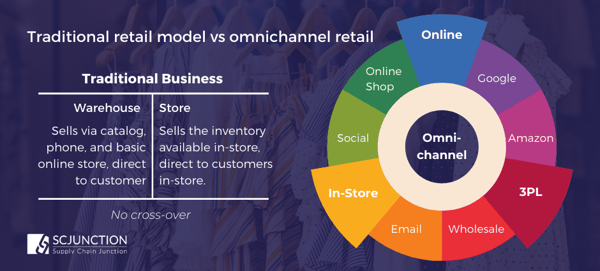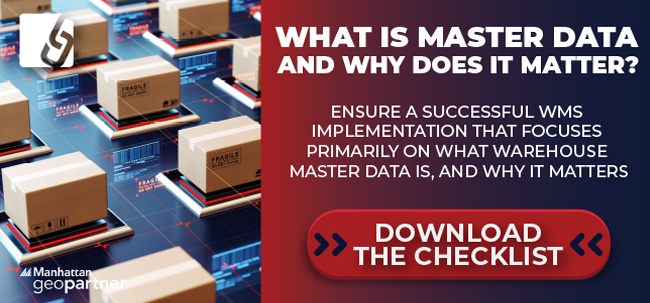The New Requirements For Omnichannel Retail Success


There are three levels of inventory insights which you need in your warehouse in order to succeed with the urgent evolution to omnichannel retail - find out what they are, and how you can successfully prepare your warehouse for a smooth transformation by benchmarking against best practices from industry leaders.
Covid has proven the scalability, flexibility, and necessity of omnichannel retail - it is the future, and it’s happening whether your business is prepared or not! Simply put, if you don’t eat your lunch, someone else is going to. So if you want your business to remain ahead of the curve, you need to understand how to use it to deliver a seamless customer experience that fulfills the complex requirements of modern buyers.
Traditional retail and its move to omnichannel

Traditional retail is defined by sales channels operating in silos. In their article about the three levels inventory insight you need to deliver omnichannel profitably, Manhattan Associates explains why this business model led to inefficiencies, and the need to revise our approach to supply chain management:
Back when online orders were fulfilled from a warehouse or three, and you trusted the inventory accuracy, it was a pretty simple decision as to which facility to source from. You selected the facility that 1) has available stock, 2) is the closest geographically to the recipient, and 3) the facility with the cheapest parcel agreement for the route needed. As online selling became more complex and inventory levels became more ‘real-time’ advancements like selling against inbound inventory or inventory located at third-party drop-shippers became more commonplace.
These capabilities require global inventory visibility - the first level of inventory for a modern retailer. Think of it as knowing where everything is, all the time.
Retailers, distributors and manufacturers have been talking about a global enterprise visibility picture for a long time, and it is the most basic capability retailers need to enable omnichannel operations – but consistent inventory accuracy is a major concern when retailers begin to expand the number of ship nodes available in their network.
When we enable the store to become a point for pickup or shipping, new kinds of constraints come into play – some pros and some cons:
Problem 1: Labour scheduling demands
Remember our associate who was picking items for an online order when an in-store customer asked them for assistance? That is just the beginning of the complexity a store adds to the fulfillment network. Since stores are not just fulfilling digital orders but are also filling on-demand requests from in-store shoppers, we have to consider that demand when sourcing inventory from that store for other channels or stores.
Problem 2: Safety stock and inventory availability
Additionally, the traditional supply chain model required carrying excess stock so that if and when a customer required a specific stock item, it was readily available. This was originally called ‘safety stock’, and was used in inventory locations to hold more items than were actually needed to prevent breaking an availability promise to a customer.
The major drawbacks of this strategy are that:
- it ties up a potentially significant amount of capital
- it creates more risk of markdowns or write-offs if the item doesn’t move as easily as predicted
- excess storage space is required
- more stock = more management
I once worked for a 3PL (third party logistics) organisation and there were millions of dollars tied up in safety stock because the inventory counts could not be trusted.
But with the rise of warehouse management solutions, RFID, mechanical automation and robotics, inventory accuracy in the warehouse rose to 99% and the concept of safety stock was abandoned.
The traditional store, on the other hand, has traditionally been notoriously poor at inventory accuracy, often hovering down around 60-70% - this is because there are a lot of moving parts, everything is unpacked and individually displayed, and potentially hundreds of people have access to the items and can move (or remove) them with little obviation.
When it comes to customer satisfaction, however, it must be noted that while the chaos of inventory within stores might have caused headaches and some shrinkage / inefficiency losses, the only ones affected were the customers who came into the store itself: if the item was there, great, they picked it up, and if it wasn’t then they went in search elsewhere. But since no one promised the item would be there, even if they left empty-handed they did not leave feeling deceived.
REVISING RETAIL: WHY OMNICHANNEL IS ESSENTIAL IN TODAY’S MARKETPLACE
The world has changed in the past five years and even more dramatically over the last six months, and no industry is more indicative of that change than retail. Forbes reports that 98% of consumers believe that purchases, deliveries and returns should be easily available across multiple channels. According to Aberdeen , companies with omnichannel engagement strategies retain 89% of their customers, compared to 33% for those with weak omnichannel engagement.
However, the execution of omnichannel is proving to be difficult:
McKinsey’s Periscope unit found that almost 8 out of 10 retailers said there was not one brand experience across their channels, even though they believe it is the top innovation to drive digital growth.
98% of consumers believe that purchases, deliveries and returns should be easily available across multiple channels
89% of customers are retained by companies with omnichannel engagement strategies
Businesses with weak omnichannel engagement retain only 33% of customers
Omnichannel has the potential to revolutionise the consumer experience - if it’s implemented effectively.
The Happy Customer - A Brief Study In Securing Omnichannel Customer Satisfaction
While price and product are still important factors, in today’s marketplace, consumer experience and delight hold the key to setting your business apart from the competition. This means that correct implementation of an excellent omnichannel strategy is key to success.
“The enablement of the store network as distribution points for inventory should be an advantage against online competitors that have no physical footprint. However, without investment in systems designed for omnichannel from the start, those stores begin to drag margins down instead of raising them up, because of all the appeasements and workarounds required to deliver on the customer promise.”
Having the right warehouse management system in place, supported by robust processes makes all the difference, as explained in this example :
If the first stage of maturity for an omnichannel retailer is global inventory visibility, the second is constrained inventory availability. Because while you cannot sell what you cannot see, you should not always sell everything you can see. Let us consider one of those complexities that the store introduces:
Suppose we have a customer using our online commerce engine and he is shopping for a medium, navy blue crew neck sweater. And also let us suppose he needs gift wrapping and he needs to get the item within one day for a party tomorrow evening. So he has ‘constraints’ that need to be applied to his view of our global inventory so we do not promise him something we cannot deliver. We would not want to simply show him every single blue sweater that fits his need in our network – because if he went to pick it up in a store that had no gift wrapping or we showed it available in a location that could not deliver in time for his party then we going to cause significant frustration and ire in that customer. So, we instead provide a ‘view’ of our global inventory that is filtered, or constrained, by the other requirements in real time to the commerce engine. While this is a simple example there could be many of these ‘views’ created and dynamically delivered to the appropriate channel based on customer need, such as an overnight delivery requirement, or a network impact, such as reduced store labour capacity.
This constrained view of inventory helps businesses to uphold their commitments to their customers however, it doesn’t determine the most profitable means to deliver on your promise.
“The third phase of inventory maturity for our omnichannel retailer is, perhaps, the most crucial – real-time inventory sourcing optimisation. It is important to offer omnichannel services to our customers in order to compete, and 76% of retail CEOs feel the next 3 years are more critical than the past 50 years.
But being able to deliver omnichannel profitably is needed to survive, and only 10% of industry leaders believe they can make a profit while fulfilling omnichannel demand.
The reason is because retailers are trying to deliver very complex capabilities with solutions that were designed when 4 or 5 distribution centers was considered sophisticated. The majority of solutions being used today were never designed with omnichannel in mind, and require a tremendous amount of effort, baling wire and scotch tape to pull off; and every one of those appeasements or workarounds erodes profitability.
There is no way for a human to consider the number of constraints required today to determine the most profitable way to source an item, when hundreds of options are available and many of them are active stores serving a local market. In our situation before of limiting the viewable inventory available to that which meets the needs of the customer, after those limits there may still be dozens or hundreds of options that could meet the customer promise of configuration and delivery or pickup time. So how do we decide where to source the item?
Heuristic computer problem-solving creates the opportunity to consider thousands of potential options in real-time to determine the most profitable option.
Consider our earlier order of the blue sweater that needs gift wrapping. We may physically have that item in a store close to the customer – and that store may provide gift wrapping. But what if we are selling blue sweaters in that store (or region) at full price as fast as we can stock them? Do I still want to source from that location? What if in another region we are marking down blue sweaters that we cannot sell on the store floor? Would it be more profitable to source one of those items, pay a slightly higher shipping cost to meet the delivery time-frames and source from the markdown stock? Probably. What if there were 300 other potential combinations of that scenario to consider?
Real-time sourcing optimisation is fast becoming critical for omnichannel merchants who are trying to maximise their margins and deliver on their customer promises.

Summary: The three levels of inventory insights which you need in your warehouse in order to succeed with omnichannel
Four further tips to help you prepare your business for omnichannel success
With these insights in mind, here are some additional tips to help you prepare your business for omnichannel success, wowing customers, soothing staff:
1. Benchmark your warehouse against global best practice
The most common mistake businesses make when it comes to benchmarking is not clearly aligning and defining their goals around global industry best practices.
Three key things to keep in mind when benchmarking your warehouse performance:
- Align your supply chain goals with your business goals, and clearly define these goals.
- Put in place a strategy and supporting processes which define your warehouse and supply chain requirements.
- Make sure you have access to quality data to help guide your decision making.
Get the benchmarking checklist to ensure you're on the right track:
2. Leverage technology to help you work faster rather than harder
A WMS provides you with data to drive your decision making (identifying things like seasonal patterns) and streamline your warehouse processes such as picking and shipping. Automating key areas of your warehouse will improve accuracy and increase staff productivity and, ultimately, boost your bottom line.
3. Optimise your inventory for fast and accurate picking and shipping
By optimising your physical warehouse layout and design, you can increase efficiency in your warehouse. Things to consider when optimising your warehouse layout include:
- Mixed SKU placement: positioning too many SKUs in a single picking location leads to errors, misplaced stock items and wasted time between picks.
- Placement of inventory: horizontal inventory placement will improve picking speed and maximise throughput. You can also standardise your inventory storage containers (with clear labels) to ensure that staff don’t waste time searching for appropriate containers for stock.
- Ongoing optimisation: slot optimisation of inventory is an ongoing process of testing and tweaking to ensure stock items are positioned in the most appropriate location in your warehouse.
4. Plan your customer journeys
Once you are physically ready to undertake an omnichannel transformation with the right systems in place, the next step is to make those systems customer-centric.
You may have a multi-channel strategy for managing these sales in your business, but a true omnichannel approach comes from understanding and ensuring that all of your channels and operations match your customer’s journey and experience.
Benchmarking your warehouse can help you achieve your business goals,but using the right data is critical to your success.
TAGS
- WMS (51)
- Warehouse Best Practice (46)
- Implementing a WMS (29)
- Managing your warehouse (19)
- Omni Channel (18)
- eCommerce (18)
- Blog (16)
- Supply Chain Best Practice (16)
- Customer Journey (9)
- Mid-Level (8)
- Warehouse optimisation (7)
- General Tips (5)
- Industry General (5)
- Information (5)
- Trends (5)
- managing your Supply Chain (5)
- saudi arabia (5)
- Press Release (4)
- smart warehouse (4)
- 3PL (3)
- News (3)
- ERP (2)
- Entry-level (2)
- ROI (2)
- Case Study (1)
- OMS (1)
- Picking (1)
- Solution-Specific (1)
- Transport Management System (1)
Take A Look At The Results Of A Successful WMS Implementation.
See how Tarsus Distribution, in collaboration with SCJ boost overall efficiency by 60%




